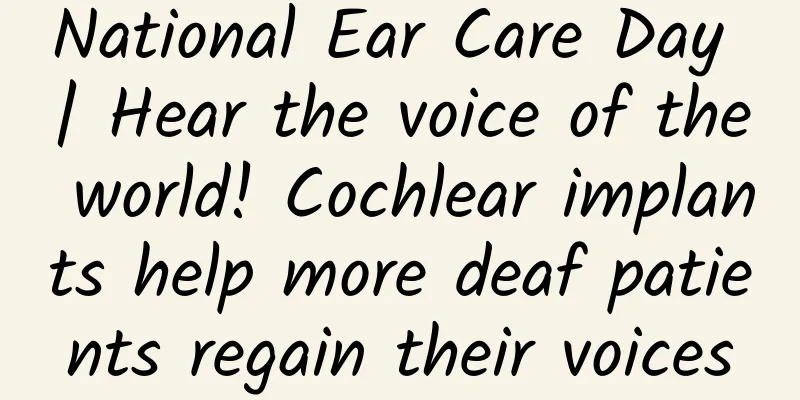National Ear Care Day | Hear the voice of the world! Cochlear implants help more deaf patients regain their voices

|
Xiaokai is 4 years old and can only say simple words such as "Mom and Dad". After a comprehensive examination at the hospital, he was diagnosed with extreme hearing loss. In October last year, he completed a cochlear implant and after rehabilitation training, he can study and live like a normal child. Feifei is almost 3 years old. She loves watching other children dance the most, but she suffers from severe sensorineural hearing loss and cannot hear any sound. Last December, she had a cochlear implant and finally can hear beautiful music. She can go to kindergarten, listen to stories and learn to dance like a normal child. Aunt Li, who is in her 50s, accidentally fell into the water when she was young, and since then, the world around her has become silent. By chance, Aunt Li heard that cochlear implants could restore hearing, so she went to the hospital for a check-up. After surgery and debugging, Aunt Li finally heard the sounds of the world again, and tears of joy blurred her vision... The World Hearing Report released by the World Health Organization (WHO) in 2021 pointed out that one in five people in the world currently suffers from hearing loss, affecting more than 1.5 billion people worldwide. Currently, cochlear implants are the most effective treatment for patients with severe and profound hearing loss to restore hearing. So, what exactly is a cochlear implant? And what kind of patients can receive one? Good news for the deaf The history of cochlear implants can be traced back to 1790, when an Italian scientist inserted two metal rods into his external auditory canals and connected a 50V current. He heard a sound similar to boiling water. This was the earliest report on the principles of cochlear implants. It was not until 1957 that, at the request of a deaf patient, Charles Eyries, an otologist in Paris, attempted to implant electrodes from physical research into the patient's ear, achieving a historic breakthrough in cochlear implant research. Although the attempt failed at the time, Charles Eyries' team firmly believed that the method they were trying would be a boon to deaf patients in the future. Subsequently, with the continuous efforts of scientists from various countries, the first batch of cochlear implants finally came out in 1976. With the world's first patient using a cochlear implant successfully recovering some hearing, cochlear implants officially entered the field of treatment for deaf patients. In 1982, Australian-made cochlear implants were approved for marketing by the U.S. Food and Drug Administration (FDA), and they have been widely used in the treatment of deaf patients. Since then, cochlear implants have opened up a new world of hearing for many deaf patients. Wide range of applications A cochlear implant is actually an electronic device that uses an external speech processor to convert sound into certain electrical signals and stimulates the auditory nerve through an electrode system implanted in the body to restore or reconstruct the hearing function of deaf patients. Cochlear implants have a wide range of applications. Generally speaking, they are mainly suitable for patients with severe and profound sensorineural hearing loss, especially children. However, there are some situations where cochlear implants are not very suitable, such as congenital auditory nerve absence or auditory nerve hypoplasia, severe inner ear malformation, auditory cortex damage and autism patients. Implant surgery has a chance For humans to acquire normal language, they need not only normal hearing, but also the normal development of the auditory language center. The auditory center has been fully developed at around 5 years old, so for children with prelingual deafness (i.e. hearing impairment before language learning), it is generally recommended that the implantation age be less than 5 years old, preferably between 6 months and 1 year old, so as to perceive hearing early, promote the development of language ability, and avoid deafness leading to muteness. Patients with post-lingual deafness (i.e., deafness that occurs after language and oral learning experience) will suffer from slurred speech if they lack sound stimulation for a long time, and they will still need a period of speech rehabilitation training after cochlear implantation. Whether children or adults with severe or profound sensorineural hearing loss, it is recommended that they wear hearing aids to prevent the deterioration of language function. When hearing aids are not effective, you can choose to receive a cochlear implant. Especially adult patients with post-lingual deafness, because they once had normal hearing, they are the best adaptable group. Generally speaking, the shorter the hearing loss time of patients with post-lingual deafness, the better the effect after surgery. If the time is delayed, the auditory nerve degeneration will worsen, which will increase the difficulty of language training and affect the effect. Common medical treatments Trauma to cochlear implants If a head injury accidentally affects the cochlear implant, first of all, you need to closely observe whether there is swelling or bulging in the cochlear implant area, and whether there are any abnormalities when using the cochlear implant. If there is no such situation, there is no need to worry; if there is swelling or hearing abnormalities, you should stop wearing the cochlear implant and go to a professional hospital for treatment. Smaller hematomas require pressure bandaging and other treatments, while larger hematomas require professional treatments such as puncture, aspiration and pressure application. Cochlear implants and otitis media Otitis media is a common ear disease, often triggered by common upper respiratory tract infections. If not treated in time, the infection will worsen and spread, causing infection around the cochlear implant. Therefore, if you experience ear pain on the implanted side, stuffy ears, or ear canal secretions, you should immediately go to an ENT specialist for diagnosis and treatment. After otitis media is confirmed, antibiotics, local ear drops and other treatments should be given to prevent the condition from getting worse. If the condition recurs and an infection occurs in the implant area, the implant should be removed in time and re-implanted after the infection is cured. Cochlear implant meets medical examination There is no need to worry about the effects of general blood, B-ultrasound, pathological examinations and common radiological examinations in the radiology department on the cochlear implant. However, if an MRI examination is required, you must be more careful. Some magnets in cochlear implants will interfere with the magnetic field and affect the MRI imaging effect; there is a risk of causing the magnet of the cochlear implant to shift during MRI imaging. Therefore, you must inform your doctor of the cochlear implant situation before the examination, and communicate with the doctor whether you can directly perform an MRI examination. If the material has an impact, it is recommended that you perform surgery to temporarily remove the implant and then put it back after the examination. When wearing a cochlear implant, you should also pay attention to the following: 1. When you don’t need to wear the device, such as when sleeping, you can take it off and store it in a dry bag/box. Remember to remove the battery; 2. Clean the external parts with a soft cotton cloth, and regularly clean the microphone, wires, battery compartment and the connection of the host; 3. Pay attention to cleanliness, moisture-proof and dryness in summer, and pay attention to anti-static in winter; 4. Try to avoid strenuous exercise, stay away from magnetic fields, and it is best to turn off the speech processor when flying. Author: Mao Changqing, Chief Pharmacist, Jinshan Branch, Shanghai Sixth People's Hospital Zhao Yan, attending physician of the Department of Otolaryngology, Jinshan Branch, Shanghai Sixth People's Hospital Review expert: Shen Weihua, deputy director and pharmacist of Jinshan Branch of Shanghai Sixth People's Hospital Liu Guiyang, Chief Pharmacist of the Fourth PLA Medical Center |
Recommend
Causes of vaginal itching and leucorrhea
We know that women are very prone to gynecologica...
What are the causes of blood clots in women's urine?
Women are also very prone to urinary diseases. Fo...
Illustration of female back pain areas
The day before yesterday, a female friend joked t...
What color is sesame paste? A guide to eating sesame paste
Sesame paste is yellow-brown in color, delicate i...
How do women maintain their uterus?
The uterus is the most important physiological or...
The best time to conceive a girl
Nowadays, many fathers feel that they must have a...
What foods are good to eat when your blood sugar is high during pregnancy
What foods should I eat if I have high blood suga...
What causes pelvic pain in pregnant women?
It is very important for pregnant women to take g...
How to adjust endocrine disorders
Many women have the problem of endocrine disorder...
Why are there no salted eggs but only salted duck eggs? How to cut salted duck eggs without breaking them
Have you ever had the same confusion? The most co...
Can I take a shower three days after an abortion?
I believe that for many pregnant women, giving bi...
What are the dangers of getting angry before menstruation?
It is very harmful to women's health if they ...
How does belly fat form? How can you lose it?
This article was reviewed by Tao Ning, PhD, Assoc...
Can pregnant women eat egg rolls?
Egg rolls are a snack that was introduced to Chin...
What is the cause of adenomyosis?
Any disease has a cause. Since we live in this bi...









